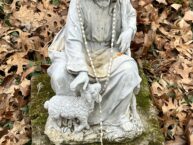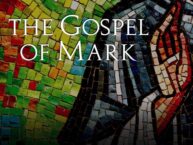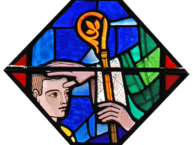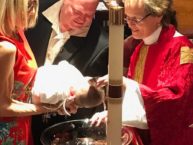 April 28, 2019: May God’s words alone be spoken, may God’s words alone be heard. Amen.
April 28, 2019: May God’s words alone be spoken, may God’s words alone be heard. Amen.
By now, most of you know that I love this gospel passage. Thomas is my favorite disciple after Mary Magdalene. Which is why it was inevitable, I suppose, that it would come back to haunt me. Back in May of 2017 I was playing golf with my buddies. I felt absolutely in the groove, relaxed, and hitting some of my best shots. And then, it happened. On the 9thhole, a short par 3 over water, I pulled out my 9 iron and swung. The ball arched beautifully over the water, landing softly on the green. As I bent down to pick up my tee, my friends started to react – “It’s in the hole! It’s in the hole!”
I looked, but from the distance I couldn’t tell for sure. Now, for those who don’t golf, you might not really understand the elusiveness of this feat for an amateur golfer. It is mostly a thing of luck, though some skill is involved, and the odds are about 12,500:1. Still, all but one of my buddies had gotten an ace, as it is sometimes referred, and I cheered along with them as they bought a round of drinks at the bar – the traditional act that is expected of any golfer who does it. But this hole-in-one achievement had eluded me for all the years I have been playing, so I told them – “I’ll believe it when I see it.”
After others took their tee shots, we drove up to the green, and sure enough – there was my ball sitting in the hole. I had done it! To which one of them said “Blessed are those who believe without seeing.” I gave her a snarky look and said “Don’t be quoting me Jesus right now.”
So, you can see that as Thomas is called the twin, I feel like I am that other sibling. Which is kind of odd, when I think about it, because as I mentioned a few years ago, going to church for me when I was young meant Sunday School, church choir, and most definitely in the summer for a Baptist – Vacation Bible School. Everyone carried a bible to church, you memorized passages and the books of the bible, sang songs about how Jesus loved the little children…and nobody ever wanted to be known as a “Doubting Thomas.” A label that we all know, comes from today’s gospel reading. And as we do every time, we must address this injustice done to him.
As I have said before, “poor Thomas. I mean, the guy goes out to use the “little disciples room” or a smoke break or whatever…and what do you know, the Lord drops by for a cup of coffee. But let’s think about this a minute…the gospel says that all of the disciples were essentially huddled in a room, afraid for their lives. Now Mary had already told them that Jesus had appeared to her, saying “I have seen the Lord!” Yet the disciples didn’t believe her. And this morning, we hear about Jesus coming into the locked room in which these disciples cowered, greeting them, and they even didn’t bother to say “hey, good to see you,” or “Mary mentioned you might be stopping by.”
So, Jesus showed them the marks in on his hands and his side. Now let me say that again… Jesus showed them the marks on his body, and then they greeted him as Lord. Even Peter and the Beloved Disciple had to see the marks to believe what Mary had said was true. Then the disciples say to Thomas exactly what Mary said to them before “We have seen the Lord!” Thomas reacts exactly like they did. Yet, look what we do to poor Thomas”[1]– forever stigmatized with a label of Doubting – but is that really a bad thing?
As I have said many times, the opposite of faith isn’t doubt. The opposite of faith is certainty. When we stop doubting, our faith becomes cemented, grounded in fear, and supported by walls of doctrine and dogma within which one can hide from challenges.The very essence of faith is uncertainty. If we know then it’s not faith, but fact. Uncertainty is the doubt that shadows faith. Faith and doubt are intertwined like darkness and light. I would argue that if one doesn’t allow for doubts in faith, one doesn’t really believe that light overcomes darkness – the very essence of resurrection.
So many people today have doubts about their religious beliefs, but are afraid to voice them for fear that it will show a lack of faith, a weakness in their commitment to God. We become like the disciples, locked inside the safety of our church walls, our church doctrine. That is one of the reasons I was drawn to The Episcopal Church, because in the words of the fabulous late comedian Robin Williams, in his Top 10 reasons to be an Episcopalian – we don’t expect people to “check their brains at the door.”
This is also why every time this gospel comes up, it is important to get past our usual associations with it, to break free from the ridiculous notion that questions are a sign of a lack of faith, or that we can’t have doubts about what we believe. But for what purpose then do we hear this passage? What is it that Jesus is doing here, and why does it matter to us? Because make no mistake about it – it does matter a great deal.
Let’s just take a step back and look at it again: Jesus enters the room, both the first time, and then when Thomas was there, saying “Peace be with you.” Now, that’s a funny thing to say to folks who have seen your crucifixion and are now seeing you raised from the dead. I mean, I might lead with “I’m baaaacccckkkk!” or really, I’d want to go to Pilate and say “Yo Pilates…want to talk about truth now?” But that is not what Jesus did, and so the question is – why this? Why a greeting bestowing peace?
To understand that, we need to think about where the disciples were in that moment – not only physically, but emotionally and spiritually too.
The disciples, the men anyway, have been locked up in a room out of fear. Perhaps another reason to admire Thomas, as he was not there behind closed doors initially. Where was he? But that is a sermon for another day. The disciples were fearful that they were going to be next on the cross. They were also deeply grieving the loss – not only of their Rabbi, but of their fervent belief that he was the one – the Messiah. In one horrible moment, they lost someone they loved, and they lost their faith. Their world was shattered. They were afraid and unsure of what to do or where to go.
Does that resonate with any of you?
I can imagine that it does. Anyone who has grieved the loss of someone they love, who has felt isolated, who has felt fearful, understands deeply some of what these earliest followers of Jesus felt. And if you do, then you know that one of the things these disciples needed most was exactly what Jesus was offering to them – Peace.
Jesus knew that they were in a tomb of their own – locked away physically, yes, but also emotionally, mentally, and spiritually. Their foundation had been built on the sand of belief that was limited in view. Jesus needed to give them a solid foundation upon which to not only live, but to be sent – to be him in the world as they were called to do now. And the core of that foundation isn’t an immature belief too afraid to acknowledge our unbelief, but of a faith rooted in the freedom to question, because we are filled with a peace that centers us, that removes the fear which often pushes us to cling so desperately to our understandings of the world and of God.
I am reminded of a story.
“Long ago a man sought the perfect picture of peace. Not finding one that satisfied, he announced a contest to produce this masterpiece. The challenge stirred the imagination of artists everywhere, and paintings arrived from far and wide. Finally the great day of revelation arrived. The judges uncovered one peaceful scene after another, while the viewers clapped and cheered. The tensions grew. Only two pictures remained veiled. As a judge pulled the cover from one, a hush fell over the crowd. A mirror-smooth lake reflected lacy, green birches under the soft blush of the evening sky. Along the grassy shore, a flock of sheep grazed undisturbed. Surely this was the winner.
The man uncovered the second painting himself, and the crowd gasped in surprise. Could this be peace? A tumultuous waterfall cascaded down a rocky precipice; the crowd could almost feel its cold, penetrating, spray. Stormy-gray clouds threatened to explode with lightning, wind and rain. In the midst of the thundering noises and bitter chill, a spindly tree clung to the rocks at the edge of the falls. One of its branches reached out in front of the torrential waters as if foolishly seeking to experience its full power.
A little bird had built a nest in the elbow of that branch. Content and undisturbed in her stormy surroundings, she rested on her eggs. With her eyes closed and her wings ready to cover her little ones, she manifested peace that transcends all earthly turmoil.”[2]
The peace that Jesus bestows on his disciples isn’t an end to conflict, turmoil, or fear in the world, but to quell the chaos within themselves. Perhaps that is why it is important to note what Jesus looked like to them. His resurrected body was not a restored body – all cleaned up without a blemish. No, it still bore the scars from his earthly life – the wounds of betrayal and pain were still there. The gift Jesus is giving them is the gift of the bird in the tree – an inner peace that will be their rock in the midst of turmoil, their nest in the swirling storms of the chaos in the world, not some sort of erasure of all of that has been, or might be, for them as they live out their call.
And we need that gift too, don’t we, for we live in a world that is far from peaceful. Heck, you can see it just reading bumper stickers on cars these days to see that peace is a rare commodity. Here are a few:
“Horn broken. Watch for finger.”
“Your kid may be an honor student, but you’re still an idiot.”
“Auntie Em. Hate you, hate Kansas, taking the dog. Dorothy.”
“Some people are only alive because it is illegal to kill.”
Of course that is a somewhat humorous view, and yet we know that this is sadly nothing to laugh about when we consider the hate, bigotry, violence, war, poverty, and oppression all around us. Just yesterday there was another shooting, another death, while people worshipped in their synagogue in San Diego. The horrors of this world are enough to make us all want to gather together someplace safe and hide.
Jesus knew that if we are ever to live as he calls us to live in the world, we had to have peace within us – his peace – “the peace which surpasses all understanding” as we hear in the blessing in our Book of Common Prayer taken from the words of St. Paul. The Buddha put it this way “Better than a thousand hollow words, is one word that brings peace.” For Christians, that one word is THE Word – Jesus.[3]
The Jesus that comes to us in our fear.
The Jesus that breathes love into our hearts.
That is the Word that brings us peace.
Jesus entered that locked room to instill his love in the hearts of those who follow him that they may be the people sent into a world in need – in need of peace, in need of love. And here’s the thing… Jesus enters into this place too. He enters anywhere we are gathered in his name, and offers his peace, his love, that we too might go into the world a people sent by him – to be him alive in the world today – to be the body of Christ we are called to be – offering the gift of his peace and love to the world in which we live.
But you might be wondering, didn’t Jesus also say that he did not come to bring peace to the world? Yes, but this is where it is important to distinguish what we mean by peace in different circumstances, because the peace Jesus is blessing his disciples with in that room is not the peace that we may seek in the world, or at least not exactly. But without the first, we have no hope of the last.
The theologian Frederick Buechner put it this way “Peace has come to mean the time when there aren’t any wars or even when there aren’t any major wars. Beggars can’t be choosers; we’d most of us settle for that. But in Hebrew peace, shalom, means fullness, means having everything you need to be wholly and happily yourself. One of the titles by which Jesus is known is Prince of Peace, and he used the word himself in what seem at first glance to be two radically contradictory utterances. On one occasion he said to the disciples, “Do not think that I have come to bring peace to the earth; I have not come to bring peace, but a sword” (Matthew 10:34). And later on, the last time they ate together, he said to them, “Peace I leave with you; my peace I give to you” (John 14:27). The contradiction is resolved when you realize that for Jesus peace seems to have meant not the absence of struggle, but the presence of love.”[4]
And there it is – “peace is not the absence of struggle, but the presence of love.” God’s love most especially.
Being a follower of Jesus doesn’t mean we won’t have fear. It doesn’t mean we won’t grieve. It doesn’t mean our lives will be without pain, or the world without tumult. It means that these things, when they happen, will not destroy us – not because we have some sort of rock hard faith that defies doubt, but because by his resurrection we know that light overcomes darkness, life is stronger than death, and love always defeats hate.
And through that knowledge, we become like that bird in the nest above the rocky precipice – aware of it, understanding the danger, but not shaken by it.
Through that, we come into the fullness of being.
Through that we are made whole – we experience Shalom…Peace.
That is why we need to hear this gospel, because this good news we hear today isn’t about removing all doubt – but about the faith that thrives with the doubt.
This good news we hear today isn’t about the disciples of long ago – but about us – the ones Jesus is sending now.
This good news we hear today isn’t about living in a world in which peace prevails – but about how to live in peace within the chaos – or perhaps most of all to BE the peace the world needs to see.
Jesus said to them, and now to us, “Peace be with you. As the Father has sent me, so I send you.”
Now what?
Now what?
Will you keep your faith within these walls, hiding it from the world?
Or, will you breathe in the Word here – to be him out there?
The peace of the world, and of your own heart, lies within your answer.
Amen.
For the audio from the 10:30am service, click below, or subscribe to our iTunes Sermon Podcast by clicking here:
[1]From my 2014 sermon titled “Faith & Doubt.”
[2]Berit Kjos, A Wardrobe from the King, pp. 45-46.
[3]From the work of the Rev. Bob Eldan on preachingtips.com.
[4]Frederick Buechner, Wishful Thinking: A Seeker’s ABC (New York: HarperCollins Publishers, [1973] 1993), 83.
The Rev. Diana L. Wilcox
Christ Church in Bloomfield & Glen Ridge
April 28, 2019
Easter 2 – Year C
1st Reading – Acts 5:27-32
Psalm 150
2nd Reading – Revelation 1:4-8
Gospel – John 20:19-31






